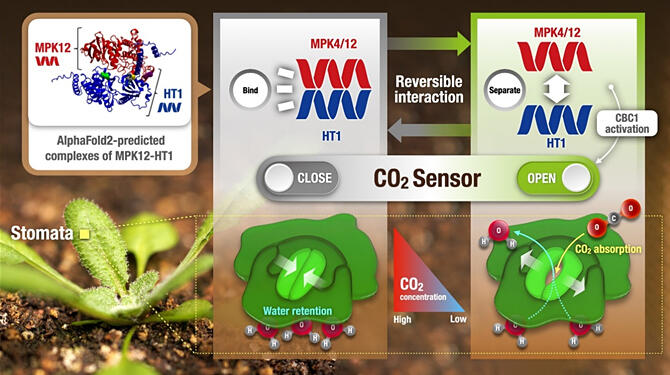The research group of Designated Associate Professor Yohei Takahashi of Institute of Transformative Bio-Molecules (WPI-ITbM) at Nagoya University and Professor Julian Schroeder of the University of California San Diego announced that they had clarified the carbon dioxide sensing mechanism in plant stomata. Using the model plant Arabidopsis thaliana (commonly known as thale cress), they showed that two protein phosphatases, MPK4/MPK12 and HT1, which work in stomata, cause the structure to open and close by binding to each other in a CO2-dependent manner. It is expected that this result will lead to improving plant water use efficiency and to the development of technologies that absorb atmospheric CO2. The results were published in the December 7 issue of the international scientific journal Science Advances.

Provided by Issey Takahashi, Institute of Transformative Bio-Molecules (WPI-ITbM), Nagoya University.
Plants fix nitrogen by taking in CO2 from the atmosphere through structures called stomata and then performing photosynthesis. The opening of a pair of stomatal pore cells promotes the uptake of CO2, but this also promotes the outflow of water molecules which are necessary for survival. It has been known for a hundred years that plants close their stomata in high CO2 environments, and it is believed that there is a mechanism that senses changes in CO2 concentration and adjusts the degree of stomata opening to control water loss associated with CO2 acquisition. On the other hand, the substance responsible for this "CO2 sensor" was unknown.
Previously, the research group reported in 2018 that the protein phosphatases MPK4 and MPK12 had the function of promoting stomatal closure. In 2006, another research group had reported that TH1, a protein phosphatase, had the function of inhibiting stomatal closure, and also reported about 10 other protein phosphatases involved in stomatal opening and closing. Protein phosphatases are known as enzymes that, via their activity, alter the on/off state of physiological reactions in plants and animals.
This time, the research group focused on the properties of the proteins that are produced by the genes that have been reported so far. To do so, they biosynthesized these proteins and investigated their interactions with, and responses to, CO2.
What they found is that the coexistence of MPK4/MPK12 with HT1 in the presence of CO2 reduced stomatal activity.
To clarify further, the research group investigated the behavior of these proteins in plants and found that their binding became stronger in a concentration dependent manner CO2. At a CO2 concentration of 100 ppm, the proteins did not bind, but at 800 ppm, they bound strongly. The same reaction was reproduced in an experiment using purified proteins produced by E. coli.
In order to actually confirm this protein binding effect in plants, the researchers observed the response to CO2 of mutant Arabidopsis thaliana that had a mutation in the HT1 gene. What they found is that this plant with the mutation did not respond to CO2. They also confirmed that the biosynthesized HT1 mutant protein does not bind to MPK4 or MPK12.
Molecular modeling predicted the structures of the HT1-MPK4 and HT1-MPK12 complexes and found that amino acids in the HT1 protein that are important for binding clustered at the interface between MPK4/MPK12 and HT1.
Furthermore, it was also found that these complexes sense CO2 concentrations and regulate the activity of downstream protein kinase CB1 activity.
The stoma opening/closing mechanism that was revealed through this study is believed to be common to all plants. In the future, the researchers are aiming to develop a drug that can control stomata opening and closing, which would have great potential for use.
Takahashi said, "I expect that this will develop into a new technology for increasing the water use efficiency of plants through enhancing their absorption of atmospheric CO2 through photosynthesis."
Journal Information
Publication: Science Advances
Title: Stomatal CO2/bicarbonate sensor consists of two interacting protein kinases, Raf-like HT1 and non-kinase-activity requiring MPK12/MPK4
DOI: 10.1126/sciadv.abq6161
This article has been translated by JST with permission from The Science News Ltd. (https://sci-news.co.jp/). Unauthorized reproduction of the article and photographs is prohibited.




